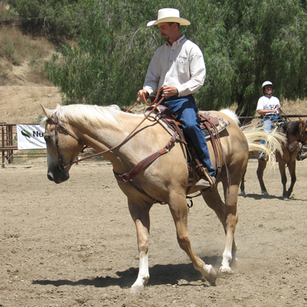What Not To Do When Your Horse Bucks Or Rears And What To Do When It Does
July 10, 2014
Written by: Keith Hosman
Written by: Keith Hosman
|
Read the following to understand why your very health depends on the work you do before you ever hit the trail - and to find out what not to do when your horse blows up.
What not to do when your horse explodes and why your health depends on work you do before you hit the trail. 
Have you heard people offer advice about "emergency dismounts," that is, how to get off your horse when it begins to bolt or buck? Well, keep this in mind: It's not staying on the horse that gets you hurt. It's the getting off part, the sudden impact with the ground. Ask any rodeo bronc rider: When did you get hurt? When you were in the saddle - or when you hit the ground?
You want to stop a buck, bolt or rear before it ever happens. You stop it before it happens by gaining control. You gain control by practicing exercises that give you finer control of the hindquarters, better back ups, stops or turns to the left or to the right. Every day keep expecting more and keep after your horse to improve. Work to a point where you know that if he "messes up," (he startles or jumps or bucks) that you will have built in enough control that it's now something you can handle. Your job right now, today, is to start making sure that you have that control. Begin seeing the exercises you do not as an end in themselves, but as tests. Can your horse stop exactly there at that rock or turn precisely at the second cone? It's not (you) knowing a lot of exercises that's important - it's having exact control over your horse's body parts throughout the exercises. If you're doing an exercise that calls for a halt at a certain point, and your horse misses by three steps, then it's telling you that you don't have the control you need of a certain body part. Practice until you can stop when and how you say. Passing that test is your proof that you have control - and that's what staying safe later (when things get hairy) is all about.
What you'll gain through diligent practice is the ability to move your horse's body parts in the only six directions they can go: forward, backward, left, right, up, down. Exercises are tests to see if you have control when you need it. Of course, more often than not, what you'll see is how little control you have. So what do if you find yourself in a bad situation? Well, what you DON'T DO is to look down and think about the ground. If your horse takes off and you look down at the ground... then guaranteed that's where you're going to hit. You've picked your spot. You'll be looking to the left, the horse will zig to the right - and you'll hit your mark, guaranteed. Instead, look right between his ears and nowhere else. Your job is to get the horse stopped, no matter what it takes. Don't be lookin' nowhere else and don't let your emotions get involved. It's okay to be afraid, but to survive you've got to stay focused on staying on and stopping the horse. Tip: Teach almost anything to your horse with the "Clock Work Exercise." That's a chapter in the basic training book "What I'd Teach Your Horse" - and you can hear the whole section right now for FREE on audio when you click here.
While there are several ways to deal with both bucking and rearing (as they happen), both can be addressed by "disengaging the hips." For example, you pick up the right rein, adding the pressure and angle that it takes to make the shoulder on the same side stop moving while the hips swing to the left. You take the "power" or "drive" away from the horse and thus diffuse the situation.
If a horse rears up, his body has to be square, two front feet planted directly in front of two back feet. During a rear, what he does is to transfer his weight to his hindquarters and then launch the front half into the air. So, if I can "take the hindquarters away" from the horse he can't rear up. It's similar with bucking: Disengaging effectively takes away 90% of the power behind the buck. He might still hop, but most likely you can ride through it. After "surviving" you can get busy with more training - giving you yet more control for the next incident. As a side note, when we say "disengage the hindquarters" what's actually happening is that one hind leg is dragging the other to the side. The leg that's being dragged is "disengaged" while the one dragging the other is actually "engaging." Picking up your right rein and asking the hindquarters to move to the left causes the left hind leg to become engaged while the right rear leg becomes disengaged. One is getting put to work, the other is "getting dragged." But either way you move the horse, the effect is the same: Just as a motorboat loses it's steam if were you to pick the motor up out of the water, so does the horse lose it's power and drive. When the horse you're riding begins to buck, you have to do whatever it takes to get through it. If you've practiced enough (before the bucking or rearing ever happens) you will have developed "brains in your hands." You might know you're in big trouble - but your hands will stay dispassionate and business like. They know the drill: "The horse freaks, I disengage, get his performance (and thus his attention) back on me." Get your horse to stop now, not later. If it takes 2 seconds to go from a walk to a stop - multiply that by 8 when he's excited. Click here to read the "Hip-Shoulder-Shoulder" 3-part series of article - and get that stop the easy way!
Print this article:
Wanna teach your horse to drop its head and stay relaxed? When you're finished with this article, click here to read about the "Classic Serpentine."
|
| ||||||

